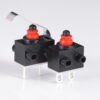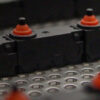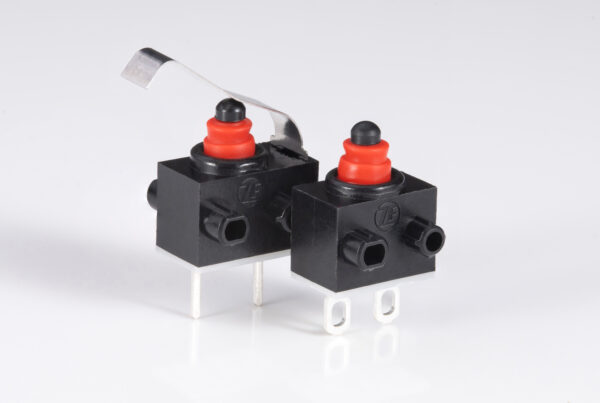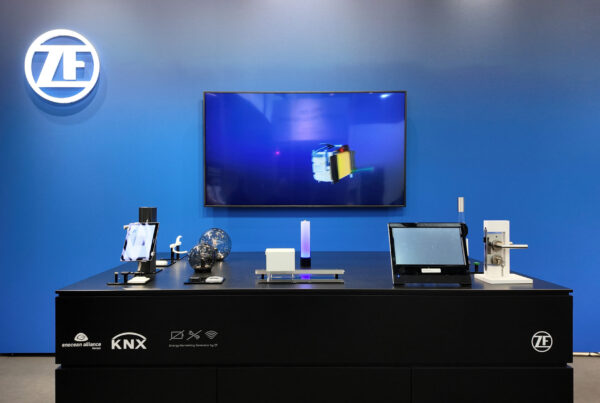
Energy Harvesting - No batteries, No wires
Energy efficiency, sustainability, smart building automation, flexibility, low system costs, connectivity – these are the main concerns for building owners. The lighting sector especially is under pressure to achieve these criteria. Electricity consumption for lighting applications in commercial and residential sectors in the US in 2019, was estimated by the EIA (Energy Information Administration) to be 5% of all electricity use.
Hence the reason why public institutions and private corporations are becoming more dependent on smart technology innovations to improve this situation. One integral component to improve this situation is the energy harvesting light and shutter switch. The special feature is that these switches operate entirely wireless and battery-free and can be used as light or shutter pushbuttons. These smart pushbuttons are developed and produced by ZF Friedrichshafen AG. The principle is to create an intelligent and flexible room concept combined with high energy efficiency and low system costs.
Wires mean inflexibility
Whether for new buildings or in retrofit buildings, wires require a detailed plan and an evaluation of project sites for suitable wire connections between several actuators, sensors, control units and receivers. Once complete it is only possible to change the positions of these modules with an investment of effort. Adjustments require a new planning phase, tear down, laying of the new wires and returning the building to its previous state. The need for electricians is essential which costs money. To gain a full picture of the budget required, it is not enough to consider only the initial costs, but also for the follow up costs if re-designs are required over time.
Batteries mean maintenance costs and waste
An alternative to cabling is RF communication between lights and pushbuttons. As soon as it comes to the decision whether to use batteries or energy harvesting technology, the initial cost consideration is still a crucial factor for building owners. To receive a full picture, further criteria need to be evaluated. These include the additional maintenance of battery changing, cost of purchase and cost of disposal. Building managers need to understand the performance of battery-powered modules and have a detailed overview of the locations of the modules, while keeping track of when to change the batteries. For hotels, airports, production halls and company offices this would mean monitoring hundreds of light switches, which are located within a large building complex over several offices and floors. If it results in an operation failure due to an expired battery, the facility manager is required to replace the battery. This results in extra work and time-consuming effort.
Further essential considerations refer to the costs of battery disposal and the waste of resources. Batteries are considered a hazardous waste. Depending on the battery type, they consist of heavy metals like mercury, lead or cadmium, which have a detrimental impact on the environment. They need to be disposed of by the end-user responsibly which is often expensive. In Germany alone, more than 80,000 tons of batteries were used in 2019. As a consequence, complicated recycling procedures take place which require a high energy effort.
Energy Harvesting Technology – no wires, no batteries
Energy harvesting solutions have the opportunity to resolve the disadvantages that come from using wires and batteries. Using ZF’s technology based on the inductive principle, a small generator can create mechanical energy typically around 330 µWs by manual actuation. This energy output is enough to reliably transmit RF commands to smart lighting applications or other smart home modules. These commands include ON / OFF and dimming of lights. The communication range varies between the protocols used and achieves up to 30 meters indoors, by the used frequency range of either 865MHz or 915MHz. The main advantage is to save effort in the field of maintenance for more than 20 years, due to the long lifetime of the energy harvesting generators. Up to 1,000,000 switching cycles can be achieved.


The RF light switch module from ZF is already available in two RF standards – KNX-RF and EnOcean3.0. In cooperation with ON Semiconductor, ZF has recently published a reference design for an Energy Harvesting Bluetooth® Low Energy switch and a first demo light switch module. It is compatible with standard frames and can also be combined with customer-specific control and design panels.
Conclusion
To free yourself from the limitations of wired systems, wireless solutions are an excellent alternative. Especially in changing building complexes, wireless light switch modules help to ensure flexible room design and rearrangement of light switches – without maintenance costs. In contrast to batteries, the self-sufficient radio variant protects the environment and resources. In addition, in a long-term perspective, the system costs decrease, since there are no internal expenses for purchasing new batteries, battery replacement and disposal.
For further information about the ZF energy harvesting product range please click here – https://switches-sensors.zf.com/cn/energy-harvesting/








